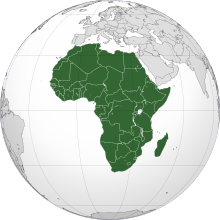Africae
Africae is the warld's seicont mucklest an seicont maist-populous continent (the first bein Asie in baith categories). At aboot 30.3 million km2 (11.7 million square miles) includin adjacent islands, it cuivers 6% o Yird's tot surface aurie an 20.4% o its tot laund aurie.[3] Wi 1.2 billion[1] fowk as o 2016, it accoonts for aboot 16% o the warld's human population. The continent is surroundit bi the Mediterranean Sea tae the north, baith the Suez Canal an the Reid Sea alang the Sinai Peninsula tae the northeast, the Indie Ocean tae the sootheast an the Atlantic Ocean tae the wast. The continent includes Madagascar an various airchipelagos. It conteens 54 fully recognised sovereign states (kintras), nine territories an twa de facto independent states wi leemitit or na recogneetion.[4] The majority o the continent an its kintras are in the Northren Hemisphere, wi a substantial portion an nummer o kintras in the Soothren Hemisphere.
 | |
| Aurie | 30,370,000 km2 (11,730,000 sq mi), 2nt |
|---|---|
| Population | 1,225,080,510[1] (2016, 2nt) |
| Population density | 36.4/km2 (94/sq mi) |
| GDP (nominal) | $2.1 trillion (2016, 5t) |
| GDP (PPP) | $6.0 trillion (2016, 5t) |
| GDP per capita | $1,809 (2016, 6t)[2] |
| Demonym | African |
| Kintras | 54 (an 2 disputit) |
| Dependencies |
Internal (4)
|
| Lairgest ceeties | Leet o ceeties in Africae |
Africae's average population is the youngest amangst aw the continents;[5][6] the median age in 2012 wis 19.7, whan the warldwide median age wis 30.4.[7] Algerie is Africae's mucklest kintra bi aurie, an Nigerie is its mucklest bi population. Africae, pairteecularly central Eastren Africae, is widely acceptit as the place o oreegin o humans an the Hominidae clade (great apes), as evidenced bi the diskivery o the earliest hominids an thair auncestors, as weel as later anes that hae been datit tae aroond seiven million years ago, includin Sahelanthropus tchadensis, Australopithecus africanus, A. afarensis, Homo erectus, H. habilis an H. ergaster—wi the earliest Homo sapiens (modren human) foond in Ethiopie bein datit tae circa 200,000 year ago.[8] Africae straidles the equator an encompasses numerous climate auries; it is the anly continent tae stretch frae the northren temperate tae soothren temperate zones.[9]
Africae hosts a muckle diversity o ethnicities, culturs an leids. In the late 19t century European kintras colonised awmaist aw o Africae; maist present states in Africae oreeginatit frae a process o decolonisation in the 20t century. African naitions cooperate throu the establishment o the African Union, that is heidquartert in Addis Ababa.
References
eedit- ↑ a b "World Population Prospects: The 2017 Revision". ESA.UN.org (custom data acquired via website). United Nations Department of Economic and Social Affairs, Population Division. Retrieved 10 September 2017.
- ↑ "IMF (WEO April 2017 Edition) GDP nominal per capita - international dollar".
- ↑ Sayre, April Pulley (1999), Africa, Twenty-First Century Books. ISBN 0-7613-1367-2.
- ↑ See Leet o sovereign states an dependent territories in Africae.
- ↑ Swanson, Ana (17 August 2015). "5 ways the world will look dramatically different in 2100" – via www.washingtonpost.com.
- ↑ Harry, Njideka U. (11 September 2013). "African Youth, Innovation and the Changing Society". Huffington Post.
- ↑ Abdoulie Janneh (Apryle 2012). "item,4 of the provisional agenda – General debate on national experience in population matters: adolescents and youth" (PDF). United Nations Economic Commission for Africa. Archived frae the original (PDF) on 10 November 2013. Retrieved 15 December 2015.
- ↑ Homo sapiens: University of Utah News Release: 16 February 2005 Archived 24 October 2007 at the Wayback Machine
- ↑ Visual Geography. "Africa. General info". Retrieved 24 November 2007.
| Wikimedia Commons haes media relatit tae Africa. |
| This Africae-relatit airticle is a stub. Ye can help Wikipaedia bi expandin it. |